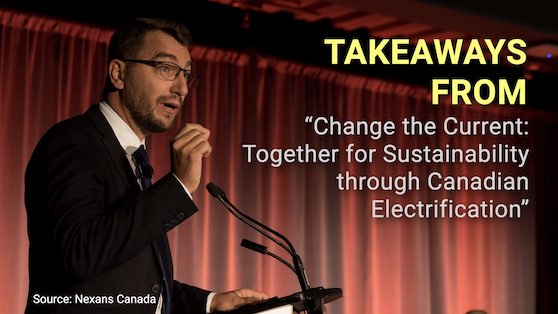
Electrified Transport
Features
News
News
Articles
Energy & Power
Transmission & Distribution
O copper, copper! Wherefore art thou, copper? Takeaways from “Change the current”
October 15, 2022 | By Anthony Capkun
 Oliver Chevreau, Nexans vice-president, Sustainability, speaks at “Change the current: together for sustainability through Canadian electrification”, September 27, 2022. Source: Nexans Canada.
Oliver Chevreau, Nexans vice-president, Sustainability, speaks at “Change the current: together for sustainability through Canadian electrification”, September 27, 2022. Source: Nexans Canada. October 15, 2022 – At “Change the current: together for sustainability through Canadian electrification”, Nexans Canada brought together thought leaders, academics, authors and industry for a two-hour conversation that explored strategies for achieving net-zero targets in Canada.
Attendees heard that most products using fossil fuels today (e.g. vehicles, homes, airplanes) will need to be electrified which, naturally, will increase worldwide demand for copper. An electric vehicle, for example, requires approx. 2-3 times more copper than a gas-powered vehicle.
While copper is seen as the backbone of electrification, mined copper cannot meet this anticipated global demand. It is estimated that the demand for copper will outstrip global supply in just two years. The United States is already consuming more copper than it is producing.
Canadian copper can help address this impending global copper shortage, provided its commitment to retrieving copper is strengthened.
Meantime, an industry-wide commitment to retrieving and recycling copper cabling is required. This can be facilitated through the design of both products and buildings with end-of-life in mind so that the metal can be easily recovered, recycled and reused (circular economy). Further, recycled copper is more efficient than virgin copper in terms of GHG emissions.
Compounding the copper problem, outdated power utility infrastructure across Canada is inadequate to support the anticipated demand for electricity, which is expected to more than double by 2050.
Meantime, attendees heard that nearly all of Canada’s electric power utilities are simply maintaining existing infrastructure—not expanding or upgrading for future demand. These utilities need to have net-zero regulated into their planning function, or else they won’t act on it.
Finally, the governance, administration and regulation of electricity systems are lacking. The speakers suggest sophisticated stakeholder understanding and public engagement are essential in gaining support for the capital expenditures that will take Canada to 2050 and beyond.
The “Change the current” conversation revolved around three key topics as they relate to electrification: raw materials scarcity and the circular economy, carbon neutrality, and renewable energy.
Participants included:
• Chris Turner, Moderator
• Jerome Leroy, Nexans
• Oliver Chevreau, Nexans
• Dr. Bruce Lourie, author
• Dr. José Etcheverry, York University
• Duncan MacLellan, City of Toronto
• Erin Andrews, SCV Consulting Ltd.
• Matthew McClearn, The Globe and Mail
You’ll find all Back Issues of Electrical Business Magazine in our Digital Archive.
Wish you were there? Don’t worry. You can watch Nexans Canada’s replay below.
— With files from Nexans Canada
Print this page
